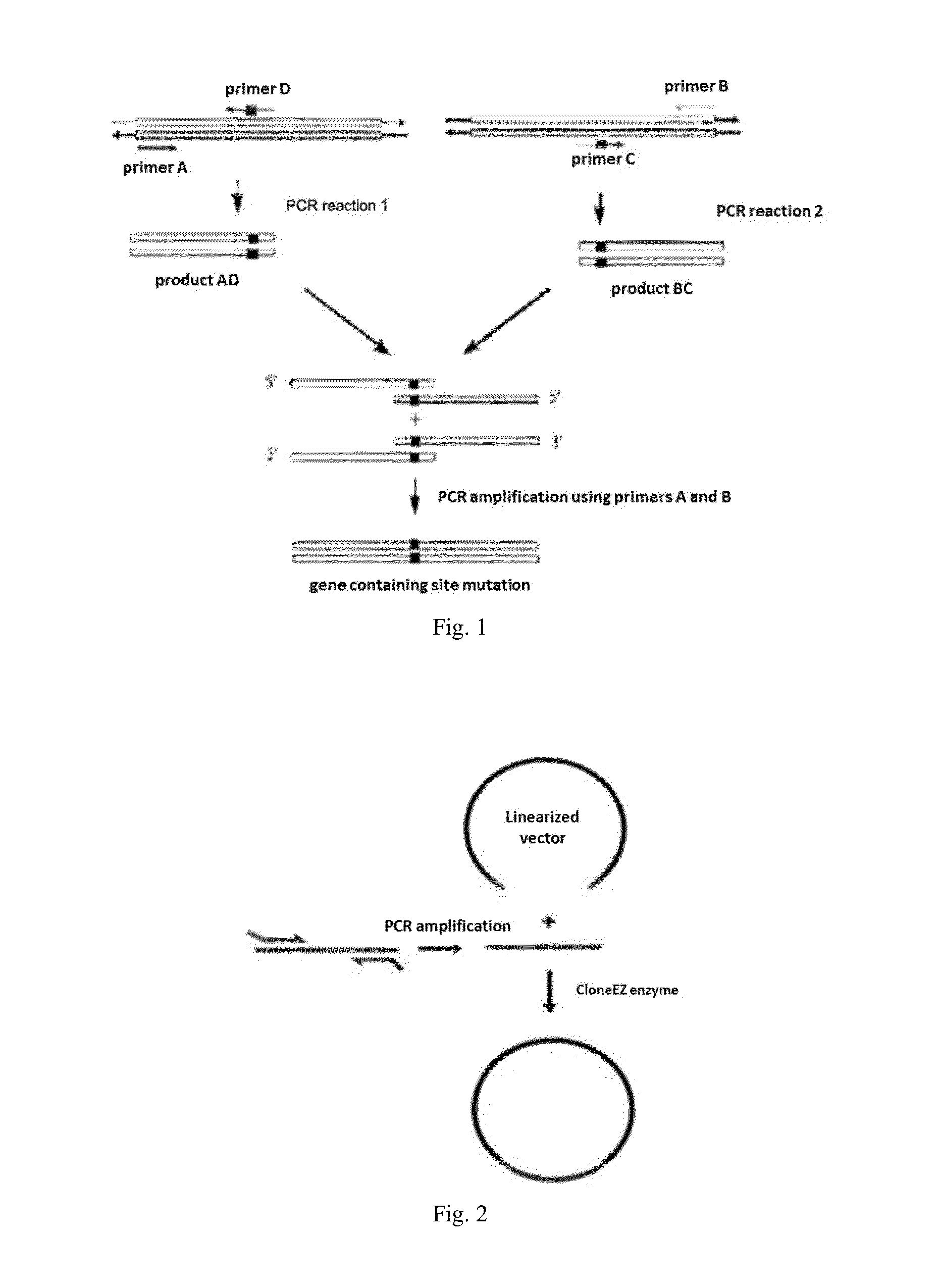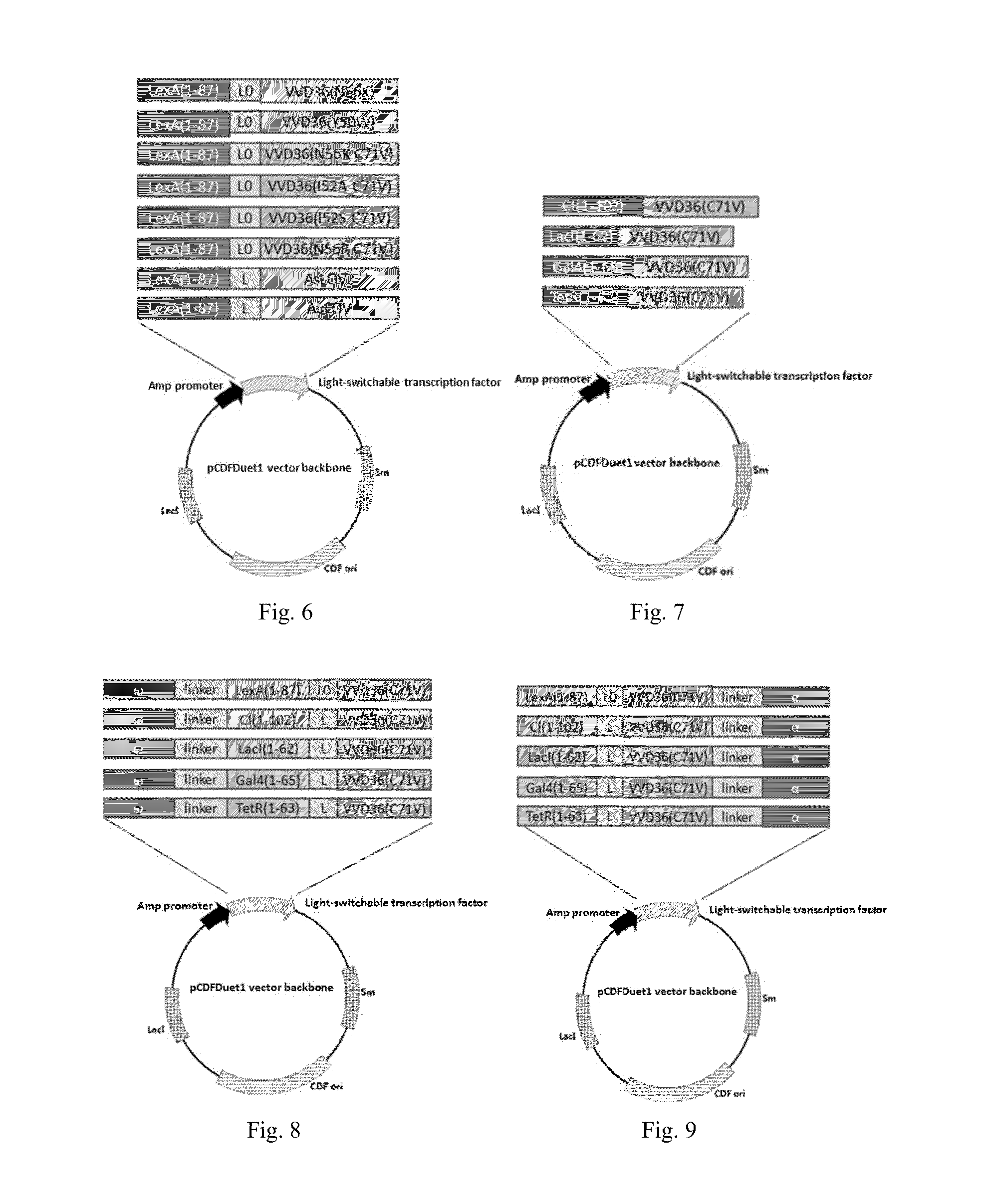Light-Switchable Gene Expression System and the Methods for Controlling Gene Expression in Prokaryotic Bacterium
a gene expression system and gene technology, applied in the field of gene expression and inducible gene expression system, can solve the problems of large toxicity of inducers, interference of transcription, irreversible damage to cells,
- Summary
- Abstract
- Description
- Claims
- Application Information
AI Technical Summary
Benefits of technology
Problems solved by technology
Method used
Image
Examples
example 1
Construction of E. coli Strains JM109(DE3,sulA−,LexA−), JM109(DE3, sulA−,LexA−,CheZ−), JM109(DE3,sulA−,LexA−,ω−), and JM109(DE3,sulA−,LexA::Amp-LV-L0)
[0194]The linearized fragment containing the homologous arm of sulA gene at the ends used in sulA gene knock-out was amplified from pKD3 plasmid by PCR using primer P1, P2, P3 and P4 (SEQ ID NO: 112). The knock-out of sulA gene was carried out on the basis of JM109(DE3) strain, the resulted transitional strain was JM109(DE3,sulA::Cam). The linearized fragment containing the homologous arm of LexA gene at the ends used in LexA gene knock-out was amplified from pKD4 plasmid by PCR using primer P5, P6, P7 and P8 (SEQ ID NO: 113). The knock-out of LexA gene was carried out on the basis of JM109 (DE3,sulA::Cam) transitional strain, the resulted transitional strain was JM109(DE3,sulA::Cam,LexA::kan). The Cam and Kan resistance genes of JM109 (DE3,sulA:: Cam,LexA::kan) strain were removed, resulting in JM109(DE3,sulA−,LexA−) strain.
[0195]The ...
example 2
Construction of Prokaryotic Bacterium Expression Vectors Containing T7 Promoter Driven Expression of Different Linkers of LexA (1-87)-VVD36(C71V)
[0197]Gene fragment encoding 1-87 amino acid of LexA was amplified from the genome of JM109(DE3) using primers P27 and P28. VVD36 (C71V) gene fragment was amplified from pGAVP(C71V) plasmid (preserved by our lab, the corresponding paper: Wang, X. et al, Nat Methods, 2012.) using primers P29 and P30, LexA(1-87)-VVD36 (C71V) gene fragment was obtained by fusing LexA (1-87) to VVD36 (C71V) using overlapping PCR. pCDFDuet1 was amplified using P31 and P32, the obtained linearized vector was ligated with LexA(1-87)-VVD36(C71V) gene fragment by XhoI and EcoRI double digestion, the resulting vector was named as pLV-L0 containing the gene of recombinant light-switchable transcription factor LexA(1-87)-VVD36(C71V) (abbreviated to LV-L0, SEQ.ID.No:48 (polynucleotide) and 49 (polypeptide)). On the basis of pLV-L0, the linker between LexA(1-87) and VVD3...
example 3
Construction of Prokaryotic Bacterium Expression Vectors Containing Amp Promoter Driven Expression of Different Linkers of LexA(1-87)-VVD36(C71V)
[0198]Amp promoter fragment was amplified from pRSETb vector by PCR using primers P41 and P42 (SEQ.ID.No:136 (polynucleotide)), pCDFDuet1 vector was amplified by PCR using P43 and P44, the obtained linearized fragment was ligated with Amp promoter fragment by NdeI and XhoI double digestion, the resulting plasmids was named as pAmp. LexA(1-87)-VVD36(C71V) fragments containing different linkers constructed in example 2 were amplified using primers P45 and P46, the resulting LexA(1-87)-VVD36 (C71V) fragments containing different linkers were ligated into pAmp by NdeI and XhoI double digestion, the resulting plasmids were named as pALV-L0, pALV-L1, pALV-L2, pALV-L3, pALV-L4, pALV-L5, pALV-L6 and pALV-L7 containing the genes of recombinant protein LexA(1-87)-VVD36 (C71V) with eight different linkers (L0, L1, L2, L3, L4, L5, L6, L7) (FIG. 5, SEQ....
PUM
| Property | Measurement | Unit |
|---|---|---|
| Gene expression profile | aaaaa | aaaaa |
| Level | aaaaa | aaaaa |
| Light | aaaaa | aaaaa |
Abstract
Description
Claims
Application Information
 Login to View More
Login to View More - R&D
- Intellectual Property
- Life Sciences
- Materials
- Tech Scout
- Unparalleled Data Quality
- Higher Quality Content
- 60% Fewer Hallucinations
Browse by: Latest US Patents, China's latest patents, Technical Efficacy Thesaurus, Application Domain, Technology Topic, Popular Technical Reports.
© 2025 PatSnap. All rights reserved.Legal|Privacy policy|Modern Slavery Act Transparency Statement|Sitemap|About US| Contact US: help@patsnap.com



